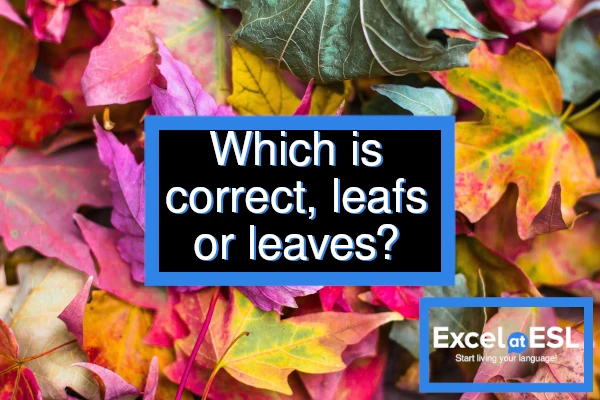English spelling can seem completely arbitrary. There are many rules for English spelling that you might know. “I” before “E” except after “C” and “U” always comes after “Q”, among others. However, there are usually exceptions to these rules. English has a long history. Throughout that history, like every other language, English has undergone changes. Sounds shift, words are borrowed, and new words are invented. All of these changes have a story behind them.
The correct plural for leaf is leaves. The word “leaf” has been in the English language since its beginning. Native English words still retain sound changes from the language’s earlier periods.
How Does the Plural for Words Ending in F Work?
In modern English, there are no longer any explicit rules for forming the plural for words ending in the letter “F”. You will now find words that end in F with regular plurals (chief and chiefs) and some that change the final consonant from F to a V (wife and wives). Below, you’ll find a table listing the three classes of word transformations for words ending in F. Those that always change, sometimes change, and never change.
| Class 1: Always Change | Class 2: Sometimes Change | Class 3: Never Change |
|---|---|---|
| loaf (loaves) | dwarf (dwarves or dwarfs) | chief (chiefs) |
| thief (thieves) | half (halves or halfs) | safe (safes) |
| knife (knives) | handkerchief (handkerchieves or handkerchiefs) | cliff (cliffs) |
| wife (wives) | hoof (hooves or hoofs) | belief (beliefs) |
| life (lives) | roof (rooves or roofs) | proof (proofs) |
| leaf (leaves) | scarf (scarves or scarfs) | |
| wolf (wolves) | ||
| self (selves) | ||
| calf (calves) |
The Story of Class 1 Words
The most interesting fact about Class 1 words is that they are all native English words (this means that these words were all in English since English split from its ancestor language).
The English language has over 1000 years of history. There were four major periods of English (the following dates are approximate):
- Old English (~600AD – ~1000AD)
- Middle English (~1100AD – ~1400AD)
- Early-Modern English (~1500AD – ~1725AD)
- Late-Modern English (~1825 – present)
During each of these periods, the English language underwent drastic changes. If you could hear an English speaker from 1000 years ago, you wouldn’t be able to understand what they were saying! Check out my article “How much of the English Language is English?” to learn more about the fascinating history of English throughout the ages!
The period of English that concerns our present question is Old English. The Old English period is the closest to when English first split away from its Germanic ancestor language. This means that, at the time, English of this period was much closer to German than it appears to be now. If you look at any Old English text, you would be forgiven for thinking that it was actually German instead!
In order to understand why the plural of leaf is leaves instead of leafs, we need to talk a bit about Old English sound rules.
Old English Sound Rules
Unlike in Modern English, there were rules in Old English for how a word is pronounced based on the other sounds that appear in the word (linguists call this ‘phonotactics’). For example, the sounds /f/, /θ/, and /s/ at the end of Old English words changed if they appeared between two voiced sounds. (A voiced sound is a sound which vibrates in your throat when you pronounce it. Sounds like the /f/ in finger are voiceless because your voice box does not vibrate while saying it, whereas a sound like the /v/ vegetable is considered voiced because your voice box vibrates while saying it.)
Let’s take a look at an Old English example of this phenomenon.
| Singular | Plural |
|---|---|
| þēof | þēofas |
The word above is the Old English word for “thief”. (If you’re curious about that letter at the beginning [þ], I’ve written a whole article about this cool little letter we’ve lost in modern English. You can check it out here!) While the word looks similar based on its spelling, we now know that, due to Old English sound rules, the pronunciation of this word would be different between the singular and plural.
This means that the final F in þēof would be pronounced the same as the /f/ sound in finger when it is singular. However, when the word is formed as the plural, the final F is pronounced like the /v/ sound in vegetable. This is because the two sounds right before and after the F (/o/ and /æ/) are both vowel sounds (which are always voiced).
During this period of English, there was no letter for the /v/ sound. /f/ and /v/ were both represented by the letter “F” and were considered the same sound. As English continued to grow and change, /f/ and /v/ were split into two different sounds represented by the letters “F” and “V” respectively.
Although we don’t have this sound rule in modern English, the legacy of this rule has been passed down to us through Old English. Words that have been in the English language for over a thousand years carry the mark of this historical rule. The word “leaf” is one of these words.
Exceptions
Of course, as with almost everything, there are exceptions. When you are talking about the leaves of a plant, the plural of leaf is always leaves. However, this isn’t always the case when it comes to stylistic concerns or verbs.
The Verb “to leaf”
One of the exceptions to this rule stems from a completely different word. When you are talking about the foliage on trees and other plants, the plural of these will always be “leaves”.
The third person form of the verb “to leaf” is “leafs”. This verb means “to flip through the pages of a book”.
- I leafed through the book to find some information.
- He leafs through magazines while waiting at the doctor’s office.
Another meaning of this verb is “to put out leaves” or “to divide a vegetable into separate leaves”. In this usage, the third person singular form of the verb is also “leafs”.
- Our tree leafs in spring.
- She leafs the lettuce by hand for the salad.
Proper Nouns
As you probably already know, proper nouns in English can ignore almost any spelling or pronunciation convention based on the desires of the person creating the name. English allows a lot of creativity when it comes to word creation and people sure do make use of it!
For our present question, an example of an exception to the “leaf/leaves” rule exists in the name for the Canadian hockey team the “Toronto Maple Leafs”

However, the reason for this exception isn’t merely stylistic concern. In English, all proper nouns take the regular plural ending even if the original noun has an irregular ending! Let’s explore this more.
Originally, the name for the hockey team comes from a maple leaf shaped badge worn by Canadian soldiers during World War I. The original owner of the team, Conn Smythe, had served in the war and based on his experiences chose to name his hockey team after these badges.
More than one Maple Leaf badge is referred to as maple leafs. This follows through into the name for the hockey team too. Multiple Maple Leaf players are Maple Leafs.
You can see this exception in the plural for the Beartooth Mountains in Yellowstone National Park. If you were to tell your friend you were going to go hiking next week, you would say you were going to the Beartooths not the Bearteeth.
This is also seen in the usage of family names. If someone had the last name “Goldman”, you would refer to their family as the “Goldmans”, not the “Goldmen”.
Slang
Another, relatively humourous, exception comes to us from slang. On the internet, leaf is used as a slang term to refer to a Canadian person.
You sometimes see this being used in forums and on social media where people from different countries are interacting with each other.
Of course, the plural of leaf when used in this context is leafs.
- Why do leafs always say “eh” when they’re talking?
Conclusion
Hopefully this cleared up any confusion you had surrounding the plural form of leaf.
Whenever you’re talking about the foliage on a plant, the plural will always be leaves. However, there are some exceptions to this as we have seen. When the word is being used as part of a proper noun, or in a slang context. Then this grammatical rule can be broken.
Remember these simple situations and you’ll never confuse the plural for leaf again!


